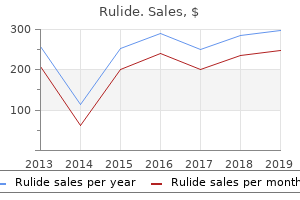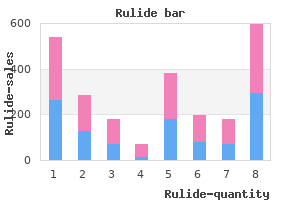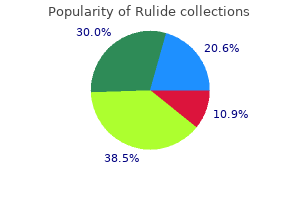

"Purchase 150 mg rulide free shipping, medications like xanax".
By: Q. Tukash, M.A., M.D., Ph.D.
Clinical Director, Joan C. Edwards School of Medicine at Marshall University
Disorder of neuronal migration (weeks 7�22 of gestation) during which a set or layer of neurons is situated between the ventricles and cerebral cortex treatment 3rd stage breast cancer generic 150 mg rulide visa. Can have a bandlike (laminar) or nodular look isodense to grey matter; could additionally be unilateral or bilateral symptoms bone cancer generic rulide 150mg without a prescription. Juvenile pilocytic astrocytoma subtype: Common in kids; usually favorable prognosis if totally resected medications you can take while pregnant for cold cheap rulide 150mg online. Anaplastic astrocytoma: Intermediate between lowgrade astrocytoma and glioblastoma multiforme; 2-y survival. Subependymal hamartoma close to the foramen of Monro; occurs in 15% of patients younger than 20 y with tuberous sclerosis. Axial postcontrast image exhibits a circumscribed low-attenuation lesion with a skinny margin of distinction enhancement within the left cerebral hemisphere. Axial postcontrast picture shows a cystic lesion with a nodular zone of contrast enhancement in the proper cerebellar hemisphere and vermis. Sagittal (a) and axial (b) postcontrast photographs show a lesion in the right frontal lobe that has peripheral distinction enhancement. Axial postcontrast picture shows a contrast enhancing lesion involving both frontal lobes and corpus callosum. Axial picture in a affected person with tuberous sclerosis exhibits an enormous cell astrocytoma on the proper foramen magnum, in addition to a quantity of calcified ependymal hamartomas. Circumscribed lesion located at the margin of the lateral ventricle or septum pellucidum with intraventricular protrusion, heterogeneous low and intermediate attenuation, with or without calcifications and/or small cysts, heterogeneous distinction enhancement. Circumscribed tumor, normally supratentorial, often temporal or frontal lobes, low to intermediate attenuation, with or without cysts, with or without distinction enhancement. Comments Uncommon slow-growing gliomas with normally combined histologic patterns (astrocytoma, and so on. Rare tumors that have neuronal differentiation; imaging appearance much like intraventricular oligodendrogliomas. Ganglioglioma (contains glial and neuronal elements), ganglioneuroma (contains only ganglion cells). Occurs more commonly in kids than adults, one third supratentorial, two-thirds infratentorial; 45% 5-y survival. Pineal gland tumors account for 8% of intracranial tumors in kids and 1% of tumors in adults; 40% of tumors are germinomas, adopted by pineoblastomas and pineocytomas, teratomas, choriocarcinomas, endodermal sinus tumors, astrocytomas, and metastatic tumors. Tuberous sclerosis is an autosomal dominant disorder associated with hamartomas in a quantity of organs. Tumors often have intermediate attenuation to intermediate to barely excessive attenuation, with contrast enhancement, with or with out central and/or peripheral calcifications. Malignant tumors are sometimes larger than benign pineal lesions (pineocytoma), as well as heterogeneous attenuation and contrast enhancement pattern, with or without leptomeningeal tumor. Cortical-subcortical lesion with variable attenuation, calcifications in 50% of older youngsters; distinction enhancement uncommon. Subependymal hamartomas: Small nodules positioned alongside and projecting in to the lateral ventricles; calcification and contrast enhancement common. Sessile or pedunculated lesions on the tuber cinereum of the hypothalamus; typically intermediate attenuation similar to grey matter; typically no contrast enhancement; hardly ever include cystic and/or fatty portions. Axial image reveals a lesion in the best frontal lobe that contains calcifications and is related to adjacent axonal edema. Axial picture in a child with tuberous sclerosis shows multiple calcified and noncalcified ependymal hamartomas, as nicely as cortical tubers and zones of low attenuation in the white matter. Lipomas can happen in many areas, commonly the corpus callosum, cerebellopontine angle cistern, and tectal plate. Circumscribed or invasive lesions, low to intermediate attenuation; variable distinction enhancement, frequent dissemination in to the leptomeninges. Circumscribed lesions involving the cerebral cortex and subcortical white matter, low to intermediate attenuation, with or with out small cysts; normally no distinction enhancement. Diffuse leptomeningeal distinction enhancement is one other pattern of intracranial lymphoma. Circumscribed tumors often positioned in the cerebellum and/or brainstem; small contrast-enhancing nodule with or without cyst or larger lesion with outstanding heterogeneous enhancement with or without contrastenhancing vessels throughout the lesion or on the periphery, Occasionally lesions have proof of latest or distant hemorrhage. Circumscribed spheroid lesions in the mind; can have various intra-axial places, often at gray-white matter junctions; often low to intermediate attenuation; with or without hemorrhage, calcifications, or cysts; variable distinction enhancement.

Goals of non-union management: Achieve fracture union No shortening or malalignment Good function of the limb symptoms 6dp5dt discount rulide 150mg line. Planning administration: Host kind Soft-tissue standing � coordinate with plastic surgeon Bone factors � alignment medications heart failure purchase genuine rulide on line, shortening treatment urticaria order rulide, bone loss, joint stiffness. Proximal femoral fracture in an osteoarthritic hip is most frequently a pertrochanteric fracture. In reasonable osteoarthritis in fit and wholesome sufferers or these with medical problems, dynamic hip screw fixation is carried out. Disadvantages are increased risk of non-union and may have additional procedures in a staged style if osteoarthritis signs worsen (removal of implants adopted by total hip replacement). Previous surgery Investigations to rule out infection and other investigations as described above Aseptic non-union: Single stage revision fixation (fixation options as above) with or with out augmentation with autologous bone graft or demineralized bone graft or recombinant bone morphogenic protein Septic non-union � staged process: First stage � removing of implants, resection of devitalized bone and soft tissues, native and systemic antibiotics, momentary spanning exterior fixation. Serial blood markers of an infection, blood cultures, repeat debridement if required. Temporary vacuum-assisted dressing Second stage � soft-tissue cowl by cosmetic surgery if required Third stage � definitive procedure with both plate or nail or circular frame as discussed above. Fracture non-union administration is a subspecialty and wishes a dedicated multidisciplinary group, together with surgical staff, physiotherapists, occupational therapists, specialist nurses, microbiologist, pathologist and radiologist. In nail fixation of femoral fractures, using the traction desk to assess rotational alignment is troublesome. In overweight sufferers the trunk can be bent away from the fractured limb to allow better access to the entry portal. Similarly, if the ipsilateral foot is placed in a boot it ought to be secured appropriately to avoid the risk of the foot coming off the boot whereas applying traction. To forestall the ipsilateral arm impeding entry to the femoral nail entry portal, the arm is held across the chest by a gentle well padded sling to stop radial nerve palsy. When the affected person is positioned lateral or inclined, acceptable measures must be undertaken to defend pressure points. The traction desk presents a number of benefits, however potential severe dangers ought to be anticipated and prevented. Risks related to orthopaedic traction tables Traction tables are used for making use of and maintaining traction for stabilizing fractures (hip, femur, tibia, acetabular), hip arthroscopy and hip alternative. To carry out these procedures the patient may be positioned supine, prone or lateral. Complications of constant stress on the perineal submit throughout traction embody pudendal nerve injury, perineal soft-tissue injury (bruising or skin laceration) and sexual dysfunction. The incidence of strain injuries is expounded to the quantity and length of traction. If extended surgery (>2 hours) is anticipated, traction ought to be released transiently. The hemilithotomy place of the contralateral limb is related to sciatic nerve harm within the contralateral leg; this could happen if the contralateral hip is flexed to 90 and the knee is at lower than 90. I will examine the affected person for respiratory fee, air entry bilaterally, tracheal position, oxygen saturation, pulse rate, blood stress and what number of oxygen the affected person is on. Closed discount and screw fixation with miss-a-nail approach; exchange the femoral nail for a reconstruction type nail. If closed reduction fails, then open discount by way of anterolateral approach and fixation as above. Either single or two implants, however femoral neck fracture is the extra necessary of the two fractures. In nail fixation, benefits include early mobilization of knee and ankle, reduced danger of malunion, but risks embrace infection, compartment syndrome and anterior knee pain. In the paper quoted there were high charges of issues within the operated group and secondary surgery to remove plate and screws. I will search for areas where the patient might be shedding blood � chest, stomach, long bone fractures and open accidents. If the patient is secure and with no other accidents, the fracture would require internal fixation with nail fixation.
Discount rulide uk. 7 ways to get past nicotine cravings.

Ependymoma Circumscribed lobulated supratentorial lesion daughter medicine rulide 150mg otc, typically extraventricular medicine you take at first sign of cold purchase 150 mg rulide amex, with or without cysts and/or calcifications medications for bipolar disorder generic 150 mg rulide amex, variable distinction enhancement. Axial postcontrast picture (a) reveals a circumscribed cystic astrocytoma within the left cerebral hemisphere, together with the basal ganglia, which has a thin peripheral rim of enhancement. Axial postcontrast picture reveals a peripherally enhancing tumor in the left cerebral hemisphere extending in to the basal ganglia. Poorly outlined low attenuation is seen adjacent to the enhancing portion of the tumor and may characterize tumor and/ or edema. Axial picture shows a nodular lesion at the proper foramen of Monro, in addition to multiple small calcified ependymal hamartomas. Axial image reveals a calcified ependymal hamartoma on the left foramen of Monro (arrow) and a noncalcified hamartoma on the right foramen of Monro (open arrow). Axial postcontrast picture exhibits a tumor involving the proper basal ganglia with mass impact and compression of the third ventricle. Comments Represent 33% of intracranial tumors, usually from extracranial primary neoplasm in adults older than 40 y. Circumscribed lesion with low attenuation sign (with or with out air-fluid level) surrounded by a thin rim of low to intermediate attenuation that shows contrast enhancement surrounded by a peripheral poorly defined zone of low attenuation representing edema; ringlike zone of contrast enhancement is sometimes thicker laterally than medially. Vary relying on organism; lesions happen in meninges and mind parenchyma, stable or cystic lesions with low to intermediate attenuation, nodular or ring enhancement, peripheral low attenuation in mind representing edema. Focal infection/inflammation of mind tissue from micro organism or fungi; secondary to sinusitis, meningitis, surgical procedure, hematogenous supply (cardiac and different vascular shunts), and/or immunocompromised standing. Complication from meningitis and/or sinusitis, septicemia, trauma, surgery, and cardiac shunt. Cryptococcus includes the basal meninges and extends alongside perivascular areas in to the basal ganglia; Aspergillus and Mucor unfold through direct extension through paranasal sinuses or hematogenously, invade blood vessels leading to hemorrhagic lesions and/or cerebral infarcts; coccidioidomycosis normally involves the basal meninges. Meningeal lesions: Nodular or cystic-appearing zones of basilar meningeal contrast enhancement. Minimal or no contrast enhancement; involves cerebral cortex and/or white matter; minimal localized mass impact. Progressive atrophy of one cerebral hemisphere with poorly outlined zones of low attenuation involving the white matter, basal ganglia, and cortex; normally no distinction enhancement. Spongiform encephalopathy attributable to slow infection from prion (proteinaceous infectious particle); often seen in adults 40 to eighty y, progressive dementia, 10% survive more than 2 y. Axial postcontrast image shows decreased attenuation involving the best frontal lobe extending in to the right basal ganglia, as properly as the left subdural empyema. Axial picture exhibits zones of decreased attenuation involving the left cerebral hemisphere, together with the left basal ganglia, from fungal an infection. Axial image shows an extensive poorly defined zone of decreased attenuation involving the best cerebral hemisphere. Acute/subacute part: Low to intermediate attenuation, with or with out rim and/or nodular pattern of distinction enhancement, with or without peripheral low attenuation (edema). Echinococcus granulosus: Single or hardly ever multiple cystic lesions with low attenuation with a skinny wall with intermediate attenuation; typically no contrast enhancement or peripheral edema except superinfected; usually positioned in vascular territory of the center cerebral artery. Echinococcus multilocularis: Cystic (with or with out multilocular) and/or stable lesions; central zone of low attenuation surrounded by a barely thickened rim of intermediate attenuation, with contrast enhancement; peripheral zone of low attenuation (edema) and calcifications are frequent. Contrast enhancement could be ringlike or nodular, often in acute/early subacute section of demyelination. Radiation Necrosis I Intracranial Lesions Abnormalities and Lesions of the Basal Ganglia. Axial image reveals a number of healed and calcified granulomas from prior an infection in each cerebral hemispheres. Diffusion-weighted photographs can present positive findings associated to decreased obvious diffusion coefficients secondary to cytotoxic edema, absence of arterial move void, or arterial enhancement within the vascular distribution of the infarct. Axial image (a) reveals a cerebral infarct (early subacute phase) within the vascular distribution of the right middle cerebral artery. Axial pictures in three different patients show cerebral infarcts in the vascular distribution of the left middle cerebral artery which are in the late subacute phase of lower than 2 weeks (b), late section from 2 weeks to 2 months (c), and chronic section of 2 months (d).

Dislocations of the ankle are described based on treatment bladder infection 150 mg rulide with amex the course of displacement of the talus and foot in relation to the tibia and are mostly lateral symptoms webmd order generic rulide online, although medial treatment nail fungus buy 150mg rulide free shipping, posterior, and anterior dislocations are additionally seen. Reduction is comparatively simple and achieved by flexing the knee to 90 levels, stabilizing the decrease leg, plantar flexing the foot, and pulling forward and reversing the course of the dislocation. Gross ligamentous disruption with or with out fracture is consistently current, and thus surgical stabilization is important on this harm. This uncommon injury is normally the result of severe torsional forces, such as in falls or motor vehicle crashes. Obvious deformity is current, and the anteroposterior radiograph can be used to verify the diagnosis. Most cases are managed conservatively with a below-knee forged with good results, though persistent limitation of motion at the subtalar joint might affect the gait. The joint consists of articulations between the bases of the primary three metatarsals and their respective cuneiforms and the fourth and fifth metatarsal with the cuboid. These joints are usually held in place by sturdy ligaments, and thus this harm is most commonly seen with high-energy mechanisms similar to motorcar accidents. Because of the robust ligamentous attachments, associated fractures of the metatarsals are often seen. Occasional vascular injury might occur in a department of the dorsalis pedis artery, which forms the plantar arch. Radiographically, the fracture dislocation may be grossly evident or quite delicate. The first four metatarsals ought to align with their respective tarsal articulations alongside the medial edges. Disruption in this area or widening across the bases of the primary three metatarsals is suggestive of an damage. Therapy of Lisfranc fractures usually involves closed discount with internal fixation using percutaneous Kirschner wires and casting. Avulsion fractures normally occur with sudden inversion of the plantar flexed foot. The insertion of the peroneus brevis has been implicated in these fractures by inflicting avulsion of the styloid process. Diaphyseal fractures often occur with running or jumping injuries, and transverse fractures inside 15 mm of the proximal bone are often termed Jones fractures. Undisplaced fractures of this type are normally handled with non-weight-bearing casting for 6�8 weeks however may require longer immobilization or surgical procedure. Complications of this diaphyseal fracture are frequent and embrace delayed union, nonunion, and recurrent fracture. These embody bilateral calcaneal accidents, lower leg damage, and vertebral fractures. Typically, significant ache and deformity across the heel is famous, and weight-bearing is unimaginable. This angle is seen on the lateral view and is the angle between traces connecting the three highest factors of the calcaneus. This angle is generally 20�40 degrees, and loss of this angle suggests compression of the calcaneus. In addition, subtalar joint involvement is essential to recognize, as many of those patients are handled operatively. In distinction, nondisplaced extraarticular fractures will typically be treated with casting for 6�8 weeks. Despite optimal therapy, chronic pain and joint dysfunction is seen in 50% of patients. Spoonamore and Demetrios Demetriades One of essentially the most devastating consequences of trauma is spinal twine damage. In the United States, roughly 10,000 spinal twine injuries yearly lead to everlasting disability. In the United States most spinal wire accidents are brought on by motor vehicle accidents (40%), violence (30%), falls (20%), and sports activities accidents (6%).